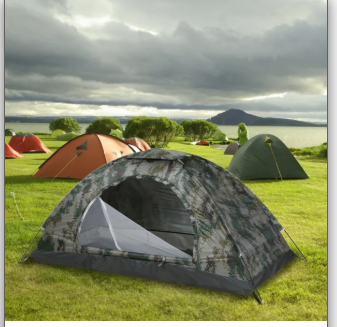
Tents are an essential part of any outdoor adventure. Whether you’re camping in the mountains or spending a weekend at the beach, a good tent gives you shelter, safety, and comfort. It keeps you dry when it rains, blocks the wind, and protects you from bugs
Types of Tents
There are different kinds of tents for different uses. Dome tents are easy to set up and have good stability. Cabin tents are bigger and give you more room inside, which is great for families. Pop-up tents are super quick to set up and are perfect for beginners. Tunnel tents offer more space and headroom, while backpacking tents are light and easy to carry on long hikes
Choosing the Right Size
Tent sizes are usually labeled by how many people they can fit. For example, a 2-person tent is made for two people sleeping close together. If you want extra space for bags or to move around, it’s better to choose a tent that’s one size bigger than the number of people. Always check the tent’s floor dimensions and height before buying
Season Ratings
Tents come with season ratings that tell you when they’re best used. Three-season tents are the most common. They’re good for spring, summer, and fall. They handle rain and light wind well. Four-season tents are stronger and made for cold weather and snow. Choose based on the weather where you plan to camp
Tent Materials
Most tents are made from polyester or nylon. These materials are light, strong, and water-resistant. The floor of the tent is usually thicker to handle rough ground. Tent poles can be made of aluminum, which is strong and light, or fiberglass, which is cheaper but heavier. Zippers and seams should also be strong and waterproof
Easy Setup
Some tents are designed to be set up quickly. Pop-up tents can be ready in just a minute. Other tents use color-coded poles or simple clips that make setup faster. If you plan to move camps often, get a tent that you can put up and take down without too much effort
Weather Protection
A good tent should protect you from rain and wind. Make sure it has a full-coverage rainfly, which is the waterproof cover that goes over the top. The bottom of the tent should be like a tub, with raised sides, to keep out water. Sealed seams help prevent leaks
Ventilation
Breathable tents help reduce condensation inside. Mesh windows and roof vents allow air to move through the tent. This keeps it cooler in warm weather and stops the inside from getting damp. Some tents have two doors, which also help with airflow
Storage and Comfort
Look for tents with pockets on the walls to store small items. Some come with a gear loft—a small shelf at the top. Vestibules are areas outside the door but under the rainfly, where you can leave shoes and bags. A tent with enough space to sit or stand makes the experience more enjoyable
Portability
If you’re hiking or backpacking, weight is important. A backpacking tent usually weighs less than 2 or 3 kg. Car camping tents can be heavier since you don’t need to carry them far. Always check the packed size to see if it fits in your bag or car
Tent Care
After your trip, clean your tent gently with water and mild soap. Let it dry completely before storing it. Never pack a wet tent or it may grow mold. Store it in a breathable bag, not tightly rolled, to help the fabric last longer
Extra Features to Consider
Some tents come with UV protection to block sunlight. Others have blackout fabric to help you sleep in after sunrise. Many modern tents also include hooks for hanging lights or fans inside. Choose the features that match your camping style
Tents for All Adventures
Whether you’re going on a solo hiking trip or a big family vacation, there’s a tent designed for your needs. From light and compact models to large and roomy shelters, having the right tent makes your outdoor time more relaxing and fun


